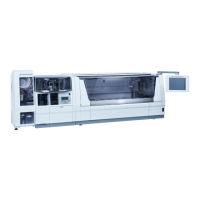AK6-QE-006-03 - 4- 05/2017
5. Installation Conditions and Environmental Requirements
* Confirm that the installation place meets the following conditions of 1) to 4).
1) Confirm in advance that the selected installation place is level and solid, providing sufficient
clearance around the system shown in Figure 5-1 (installation space).
Confirm that the installation place is free of obstacle that may block the ventilation grill on the
back of the system.
2) Confirm that the power source meets the power requirements below.
(The instrument has a universal voltage system and is compatible with the following power
sources, but the system needs to be switched to a proper power voltage by using four
changeover switches.)
Power Requirements
・Single phase, AC100V±10% 50/60Hz 15A or more Outlet with grounding electrode
・Single phase, AC115V±10% 50/60Hz 15A or more Outlet with grounding electrode
・Single phase, AC230V±10% 50/60Hz 7A or more Outlet with grounding electrode
* Forbid the instrument to be used with improver power source, such as 200VAC, that does not
satisfy the above requirements.
* Connect the instrument to a dedicated power outlet and line (including a circuit breaker). If not,
the circuit breaker will trip and other electrical equipment may be affected when an abnormal
condition occurs in the instrument.
● Specifications of power cord provided with the instrument
Cord Type Destination Standards Length
For 100/115VAC SFA, SFJ UL/CSA, PSE-approved Approx. 2m
For 230VAC SFE
Cord: CENELEC HD, VDE-approved
Plug: EN, IEC, VDE-approved
Connector: EN, VDE-approved
Approx. 2m
* If the instrument is used in regions where above standards are not applicable to, a different
power cord appropriate for use in such a region must be prepared separately.
* Grounding
Explain customer about the importance of grounding for safety’s sake and make them
understand well.
Confirm that the power outlet to be connected is properly grounded with a person in charge of
electrical facilities.
3) Confirm that a customer site provides a ventilation system, a local exhaust system or an exhaust
port to discharge treated air to the outdoors.
The amount of vapors exhausted from the instrument varies depending on reagents or staining
programs to be used and ambient temperature. The discharge amount per hour is listed below
as a reference.
Based on the values below and a cubic capacity of the installation place, check if a ventilation
rate in the place meets the workplace environmental exposure level required.
If a ventilation system is not provided, use a 38mm or 75mm dia. exhaust duct connection
adapter (option) to connect a duct hose to the exhaust port on the instrument and discharge
treated air to the outdoors.
* Maximum amount of exhausted gas per hour (reference)
Ethanol : 3.9×10
-3
(m
3
/hr)
Xylene : 4.8×10
-4
(m
3
/hr)

